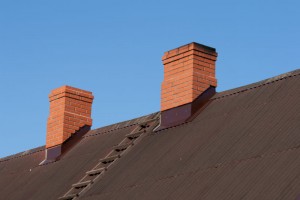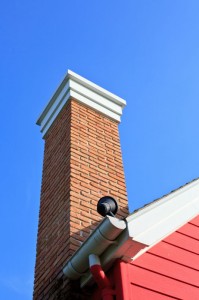by Billy Sweet | Mar 10, 2015 | Chimney Flashing
The bad news is that your roof may leak from time to time, especially after heavy rain or snowfall. The good news is that often the repair is as simple as replacing the flashing, rather than replacing the entire roof. Chimney flashing is not a shingle, but rather a detail that is installed in order to seal the joints that connect the roof to the chimney. These joints are not water tight, so thorough, professionally installed chimney flashing will help keep water away from your chimney. The result is not only a dry chimney, but also a dry and protected home interior.

Types Of Chimney Flashing
There are a few different types of chimney flashing. Aluminum is common and inexpensive, however it is susceptible to corrosion, so it may need to be replaced every so often. Vinyl is another popular choice because it is still affordable but not as durable as other materials. Vinyl can become brittle and crack under harsh weather conditions and like aluminum will probably need to be replaced. On the other hand, steel is more expensive and takes longer to install, but is one of the more durable choices because it will not corrode. Similarly, copper flashing is the most widely recommended material for flashing because it will not corrode or crack but is lightweight like vinyl. Keep in mind, copper is the more expensive option, but after initial installation copper will not need to be replaced and will likely last as long as your roof.
Without Flashing You Can Damage Your Chimney
As a homeowner, if you are wondering whether or not flashing is important, let us save you some time. Flashing is very important! Without proper protection from external elements, your chimney could be vulnerable to water damage. Chimneys are made from brick and concrete, and if exposed to rain and snowfall over time, these materials can chip, crack and crumble. The result is almost always expensive chimney repairs that could have been avoided. If you do not install proper flashing you could be damaging your roof, and leaving your ceilings and wall treatments susceptible to leaks. Flashing is a simple and necessary installation that can save you a lot of homeowner headaches.
It is important to install flashing, but it is equally important to have your chimney inspected to make sure your chimney flashing is doing its job. Depending on the materials used in initial installation, the flashing material could have been damaged, or the joints could have loosened, which is why it is so important to have your chimney regularly inspected by a professional inspection company.
Always Have A Professional Install Your Chimney Flashing
Installing flashing is a task that is best left to the professionals. The experts at Billy Sweet Chimney Sweep in Boston have years of experience inspecting chimneys and making sure flashing is installed properly. If you attempt to install your own flashing you run the risk of installing it incorrectly as well as injuring yourself in the process. Trust the experts to help you maintain your home and recommend the chimney flashing products that are right for your chimney and right for your home maintenance budget.
by Billy Sweet | Oct 15, 2014 | Masonry Chimney
The autumn weather has arrived in full force. The chilly wind has colorful leaves falling from the trees and has everyone digging up their cozy jackets. This time of year also has homeowners thinking about how to heat their homes. In the frigid New England winters, this is a big concern. Many homes utilize fireplaces for some or even all of their heating needs. With a fireplace, however, comes some maintenance responsibilities. Fireplaces with masonry chimneys, in particular, are prone to specific types of issues, so you need to keep an eye out for the safety of your home and family.

A major issue that masonry chimneys face is water damage. Many homeowners never even consider that their strong, robust chimney could ever succumb to damage from a little water. Chimneys are built to live outside, after all. Unfortunately though, water can cause serious problems. The materials used to build a masonry chimney like brick, mortar, and concrete are all very porous, meaning they readily absorb water. While stones do not absorb water, the mortar holding them together does. The trouble with a masonry chimney filled with water occurs during the freeze and thaw cycles of winter. The water expands as it freezes, which means the bricks, the mortar, and the concrete all expand as well. Over time, this expansion causes damage.
You may see water damage in several different forms. The first clue is cracked or missing mortar. The constant movement of the materials during freezing weather loosens the bonds of the mortar. Thus, the mortar wiggles its way out from between the bricks, appearing as a crack or as a decent sized hole. A mason can usually fix isolated mortar cracks or holes using a process called tuckpointing.
Another sign of water damage is a cracked chimney crown. This concrete slab on top of your chimney acts as an umbrella to keep water from entering the flue. If it has cracks from water damage, water is entering your chimney, which leads to a whole new set of problems. Ask your mason if he can patch the cracks. Otherwise, the chimney crown may need to be completely replaced.
The most devastating sign of water damage to the chimney is partial or total collapse of the structure. This most likely occurs after years of exposure to water and freezing temperatures, but a poorly built chimney could suffer from collapse in less time. Chimneys are very heavy, meaning a collapse could be a danger to anyone on the ground and to the structure of your home. Any signs of a collapsing chimney must be addressed by a mason right away.
Luckily, you can take some steps to prevent water damage, like sealing your chimney and adding a chimney crown. Ask your mason what can be done to protect your chimney. If you live in the Boston or North Shore area or around Portland, Maine, contact Billy Sweet Chimney Sweep for a professional consultation. The experts at Billy Sweet Chimney Sweep can help make your chimney last for many more years.
by Billy Sweet | Dec 31, 2013 | Chimney Maintenance
Chimney Caps: Your Best Defense from Water Leaks
 Chimney leaks are a common problem in any home especially during seasons when rain is pouring non-stop. Leaks happen when water seeps inside your chimney. They occupy the little openings and cracks in the masonry walls and some go all the way down to the chimney flues and other major parts. A typical rainy day isn’t something to get all jumpy and panicky about, but if the problem is left unfixed, it will eventually cause a bigger problem for you in the long run.
Chimney leaks are a common problem in any home especially during seasons when rain is pouring non-stop. Leaks happen when water seeps inside your chimney. They occupy the little openings and cracks in the masonry walls and some go all the way down to the chimney flues and other major parts. A typical rainy day isn’t something to get all jumpy and panicky about, but if the problem is left unfixed, it will eventually cause a bigger problem for you in the long run.
Here at Billy Sweet Chimney Sweep, we want to thoroughly discuss with you the problem on leaks. Because this problem in particular is the main source of a lot of major problems in the house like carbon monoxide poisoning, molds and the gradual destruction of your chimney walls.
Preventing Leaks with a Chimney Cap
The main reason why leaks happen is the lack of having a chimney crown and chimney cap. They are your first and ultimate line of defense in protecting your chimney. They prevent external factors from getting in, most especially water which could damage your chimney’s walls and overall structure. This is the best way to waterproof your chimney and fireplace. Installing a chimney cap will definitely do the trick and will absolutely help your chimney be more efficient and it will last you more years than expected.
It’s always best to seek professional help in installing the chimney caps. It’s a no-no to do it yourself because before we even install a chimney cap or crown, we still have to inspect and survey the chimney for any other damage or repair it may need. We at Billy Sweet Chimney Sweeps make sure that your chimney is protected from any leaks, blockages or any occurrence of that sort. You might spend a few extra dollars but rest assured, it will be money well spent.



